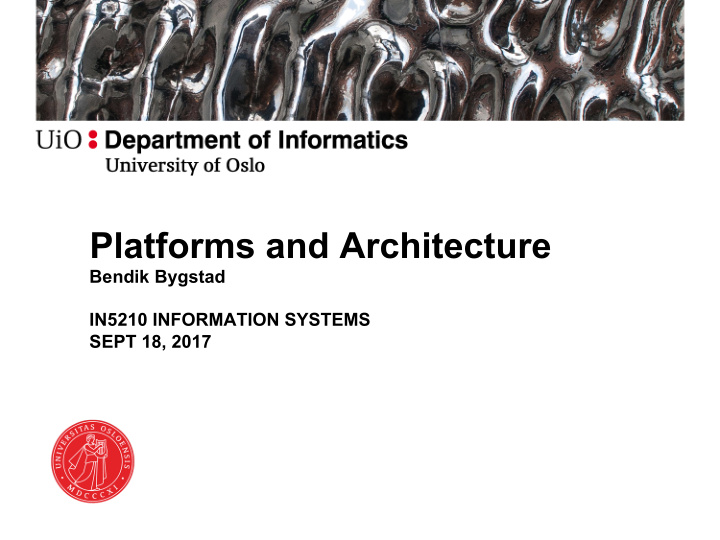



Platforms and Architecture Bendik Bygstad IN5210 INFORMATION SYSTEMS SEPT 18, 2017
Learning outcomes First session • Overview of IT architecture principles; modularization, loose coupling etc. • Understand the technical and economic aspects of platform ecosystems Second session • Appreciate the difference of heavyweight and lightweight IT • Reflect on the nature and scope of digital platforms Bygstad 2017
Three levels of IT architcture Level Purpose: Dealing with complexity 1. Enterprise Architecture The business processes and IT resources 2. Service Oriented Connecting processes and systems Architecture (SOA, SIAM) through loose coupling 3. System/Applications Components and layers architecture Bygstad 2017
Application: Layers pattern Larman, G. (2004) Applying UML and Patterns. Bygstad 2017
SOA Example: Bus architectures ! Bygstad 2017
Andrew Martin (2012): Enterprise IT Architecture in Large Federated Organizations: The Art Enterprise Architcture: Pharma Ltd of the Possible Bygstad 2017
Tiwana: Platforms Ecosystems A digital ecosystem consists of the collection of platform and the apps specific to it. Tiwana 2014 Network effects Architecture Governance Tuning Bygstad 2017
Plattforms and ecosystems Traditional ecosystems • Cities • Markets • Airports Digital ecosystems • Apple • Google • SAP • Altinn • Finn Bygstad 2017
Digital ecosystems Bygstad 2017
ECONOMIC PERSPECTIVE TECHNICAL PERSPECTIVE (Parker, van Alstyne, Choudary 2014) Tiwana 2013. Platform Platform “A business platform is a nexus of rules “A platform is the extensible codebase of and infrastructure that facilitate a software-based system that provides interactions among network users. core functionality shared by apps that A platform may also be viewed as a interoperate with it.” published standard, together with a governance model, that facilitates third party participation”. Ecosystem Ecosystem A digital ecosystem consists of the Two or n-sided markets grow by collection of platform and the apps network effects, not on traditional specific to it. economies of scale. Bygstad 2017
Tiwana: Platform Ecosystems Architecture - Organisation of elements Governance - Organisation of decision rights Bygstad 2017
Global distribution (Parker, Alstyne, Choudary, 2016) Bygstad 2017
Two conflicting trends in eHealth Heavyweight IT Lightweight IT - ”Silos”, fragmented, expensive - Innovative, user friendly, low cost - Reliable, secure - ”Shadow IT”,security/privacy issues ”Consumeri- zation” ! IT Architecture at Helse Sør-Øst EPR, clinical systems, BizTalk ”Internet-of-Things” and 275 physical integrations ”Robotic Process Automation” Bygstad 2017
Heavyweight- and lightweight IT Heavyweight IT Lightweight IT Profile Back-end: Documentation Front-end: Support work processes Systems Journal, lab, imaging etc. Process support, apps, BI Tech-nologies Servers, data bases, middleware Tablets, electronic boards, mobile phones, sensors Architecture Centralised or distributed Meshworks Owner IT department Professional users, vendors, patients Culture Systematics, quality, security Innovation, experimentation Discourse Software engineering Business innovation Challenges High costs, increasing Isolated “gadgets”, data management, complexity security Knowledge “A knowledge regime, driven by “A knowledge regime, driven by competent regime IT professional, built on users’ need for work support, built on systematic requirements mobile digital technology, and realised specification, and realised through innovation processes ” through software engineering” Bygstad 2017
Good heavyweight IT: Helse Sør-Øst regional integration platform Bygstad 2017
God lightweight IT: St.Hanshaugen town district in Oslo • Controlled by patients • Surveilled by health personnel • Simple, flexible • Contact: Sven Bue Berger Bygstad 2017
Interplay of Lightweight and Heavyweight IT Technology: Mobile, Internet-of-Things Light- Development: Iterative, experimental weight IT Applications: Supporting the immediate need of users Technology: Large systems, integration Heavy- Development : Systematics, security weight IT Applications: Basic registers, transactions Bygstad 2017
Assumption: Generativity arises from the interaction of loosely coupled heavyweight and lightweight IT • Loose technical coupling: ”Interaction, not integration” • Loose coupling on standards: Don’t stop the innovation process by early standardization • Loose organisational coupling : Different knowledge regimes, different vendors Bygstad 2017
Kalnes in Østfold: Combination of lightweight- and heavyweight IT Lightweight Heavyweight Bygstad 2017
References • Sia, Soh and Weill (2016): How DBS Bank Pursued a Digital Business Strategy. MISQ Exective, 15(2):105-121. • Bharadwaj, A., El Sawy, O. A., Pavlou, P. A., & Venkatraman, N. (2013). Digital business strategy: toward a next generation of insights. MIS Quarterly, 37(2), 471-482. • Gizaw, Bygstad and Nielsen (2016). Open Generification: A Design Strategy for Health Information Systems in Developing Countries. Information Systems Journal. • Staring and Titlestad (2008). Development as a Free Software: Extending Commons Based Peer Production to the South. ICIS 2008. Bygstad 2017
Recommend
More recommend